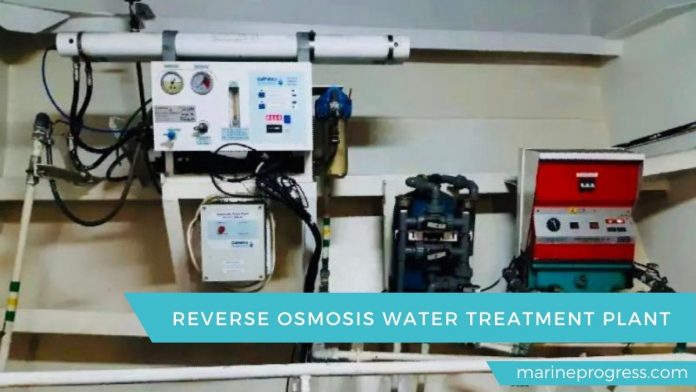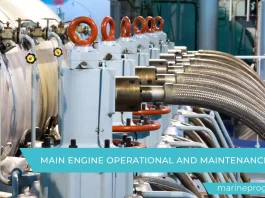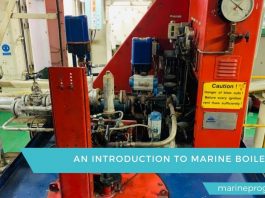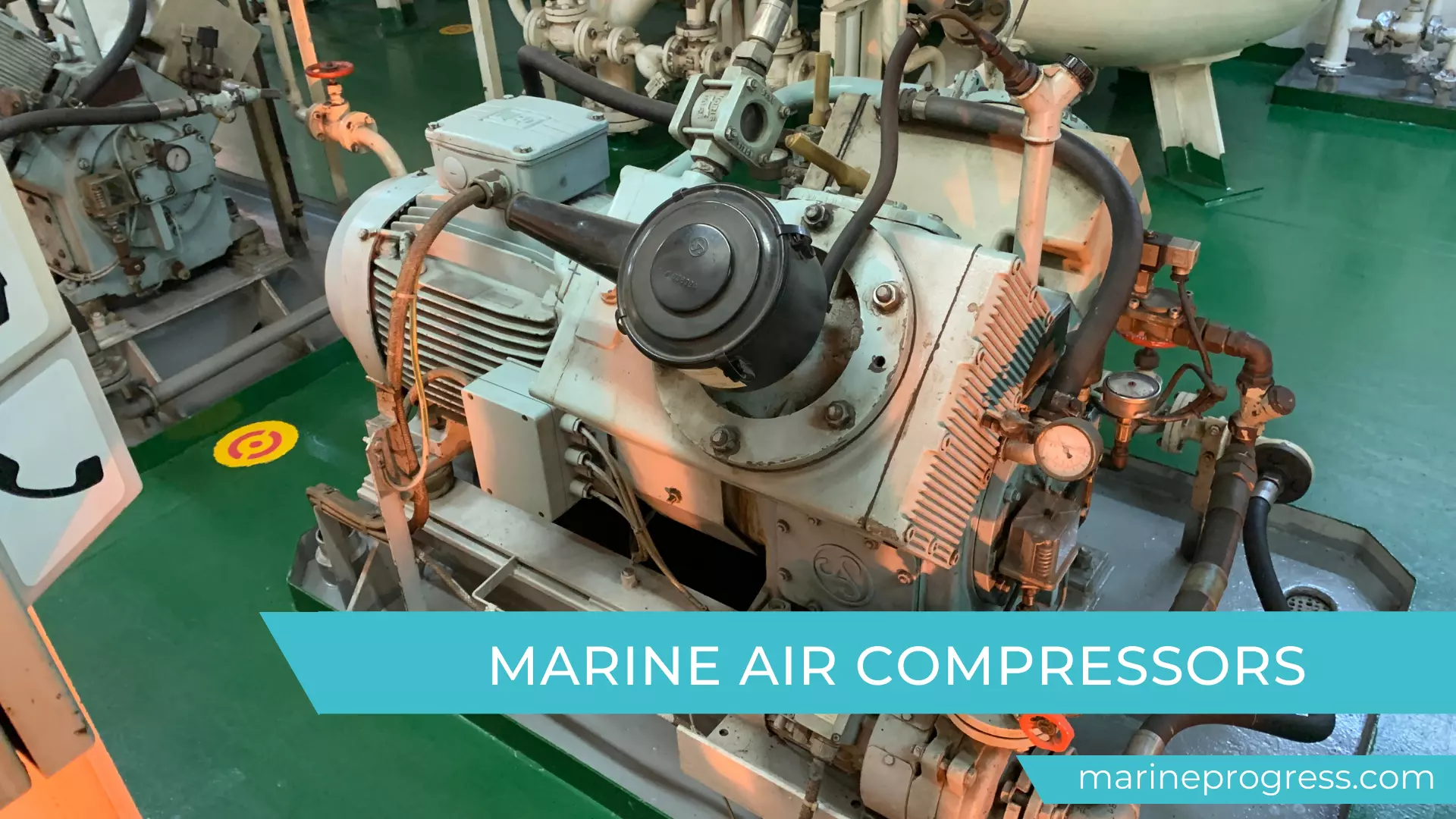Table of Contents
Osmosis describes the process whereby a fluid will pass from a denser to a less dense solution through a semi-permeable membrane. It is very important to the water absorption processes of plants. Reverse osmosis is a process that uses a semipermeable membrane that retains both salt and impurities from seawater while allowing water molecules to pass. Filtration of up to 90% is possible making the produced water unsuitable for boiler feed without further conditioning. Improved quality is possible using a two or more pass system.
Semi-Permeable Membranes and Type
The parchment paper acts as the semi-permeable membrane and allows the water molecules to pass but not the larger salt molecules.
Reverse osmosis is the process whereby pressure is greater than osmotic head pressure. This applies as a solution of high density. The fluid is forced from the high-density side to the less dense side.
For desalination plants, the pressure applies to seawater and the water forced through the semi-permeable membrane.
The semi-permeable membrane typically makes of polyamide membrane sheets wrapped in a spiral form around a perforated tube resembling a loosely wound toilet roll.
The design of the cartridges is therefore such that the seawater feed passes over the membrane sheets so that the washing action keeps the surfaces clear of deposits. A dosing chemical also injects to assist the action.
The two membranes sealed on the outer three edges, enclose a porous under-layer through which the permeate spirals to the central collecting tube.
Pressurized feedwater passes lengthways through the tubular spiral membrane element. Freshwater permeates travels through the membrane layers as directed along with a spiral bath into a central perforated tube. At the same time, the brine discharge out the end of the membrane elements.
The fluid could be water and the solutions seawater. Under normal conditions, the water would pass from the less saline solution to the more saline solution until the salinity was the same. However, this process will cease if the level in the more saline Side raises to a difference greater than the Osmotic height.
For practical use to allow the generation of large quantities of water, it is necessary to have a large surface area of the membrane which has sufficient membrane which has sufficient mechanical strength to resist the pressurized seawater. The spirally wound polyamide or polysulphone sheets use for seawater purification. One problem with any filtration system is that deposits accumulate and gradually block the filter. The seawater supplies at a pressure of 60bar, a relief valve fitted to the system. The Osmosis production plant is best-suited for the production of large quantities of water rather than smaller quantities or Steam plant feed quality.
Pre-Treatment and Post-Treatment
Seawater feed for reverse osmosis plant has pre-treated. The scale inhibitors such as sodium hexa meta phosphate/ sodium hexa phosphate use to assist wash through of salt deposits on the surface of the elements, and the seawater is sterilized to remove bacteria that could otherwise become resident in the filter. The chlorine reduces by a compressed carbon filter while solids are removed by other filters. Treatment is also necessary to make the water drinkable.
Rochem Disc Tube Reverse Osmosis Plant
The disc tube module is supposed to have the main advantage over the spiral wound type in that it avoids the need for difficult cleaning processes required. With long-lasting membranes, typically 5 years and an inbuilt cleaning system the unit will recover 30%% as puree water from seawater passing through it.
Recent research requires that more close attention pays to the quality of freshwater storage and disinfection potential dangers of bacteria such as legionella or the prescience of toxic chemicals.
RO Advantages Over VCD and Evaporators
RO membranes and systems work very well on seawater. The RO systems were tested by the in-service for over 20 years, replacing the distilling units.
- The RO system uses less energy 0.0328 KWh/Gallon
- Lower heat in the machinery space
- Smaller size and weight
- Lower initial costs
- Lower operating (energy) costs
- The Ro does not require acid descaling
- Lower maintenance and corrosive chemical handling due to the acid descaling
Freshwater loading and supply arrangements
Dedicated hoses use to load fresh water from mains or water barges. Every effort should take to avoid possible contamination of the loading line and manifold
Type of Scales
Prevention of Scale Formation- Operational Problem
Calcium Sulphate (CaSO4)-1200ppm, scale formation is principally on density, remains in the solution below 140°C and/or 96000ppm. The worst scale forming salt forming a thin hard greyscale
Magnesium Hydroxide Mg(OH)2
remains in the solution below 90°C
Magnesium Bi-Carbonate1 50 ppm
soluble below 90°C, forms a soft scale, prevention by keeping the operating temperature of evaporator below 90°C
Above 90°C
breaks down to form MgC03 and CO2 and then Me(OH)2 and CO2
Calcium bicarbonate Ca(HCO3)2 180ppm
Slightly soluble, above 65°C breaks down to form insoluble calcium carbonate forming a soft white scale. scale formation prevented by chemical treatment
Ca(HCO3)2 = Ca + 2HCO3
2HCO3= CO3 + H20 + CO2
Calcium carbonate
SW containing calcium bicarbonate breaks down to calcium carbonate & precipitates as scale on the tube surface
If heated up to approximately 80°C
COs+ Ca= CaCO3
If heated above 80C
CO3 + H20= HCO3 +OH
Mg+2OH = Mg(OH)2
Hence if seawater in the evaporator heats to a temperature below 80°C, calcium Carbonate predominates. If it heats above 80°C then the magnesium hydroxide scale will deposits.
Sodium Chloride 32230 to 25600ppm -generally ignored
Soluble below 225000ppm forms a soft encrustation, free ions promote galvanic action. it is unlikely to precipitate and can remove easily.
Methods of Controlling and Minimising Scale (Evaporators)
Use low-pressure evaporation plant-Operating at a temperature below 80oC so that the calcium Carbonate scale predominates. That is a soft scale that can easily remove and is not such a poor conductor of heat.
Use magnetic ” treatment-A unit consisting of permanent magnets, preceded by a filter. It was installed in the evaporator feed line. The water passes through a strong magnetic field which alters the charge on the salts. So that amalgamation of the salt crystals, formed during precipitation in the evaporator, can prevent. The salt then goes out with the brine.
Use flexing elements-a heating element made of thin gauge Monel metal built like a Concertina. The advantage of such an element is that when Pressure, and hence Temperature, vary slightly the element flexes considerably thereby cracking of scale effectively and permitting longer running periods of the evaporator between shul downs. Proper care should have not submitted the element to over pressurization.
Use continuous chemical treatment
Maintenance
Continuous chemical dosing during operation
Periodic chemical cleaning of evaporator and condenser
Treatments
Ferrous chloride-FeCl2- Keeps pH too low for Mg(OH)2 and CaCO3; to decompose to form scale.
sodium sulphate-Na(SO4)2 or HCI and Corrosion inhibitor alternative; Rubber lining necessary to protect the shell from acidic water.
Sodium polyphosphate -this will delay the Calcium Carbonate precipitation if the temperature is maintained below 80
Prevents scale formation below 80oC
-The mixture of different phosphates
Sludge (coagulant and antifoam) conditioners
-Can use with potable water
Polyelectrolytes
-Prevent scale above 80oC
-safe with potable water.
Drinking-Water
If it boiled at temperatures above 75 C most of the bacteria will not die-most of the low-pressure plants operate at temperatures ranging from 40°C to 60C
Additives to diesel engine cooling water are not harmful. Those not allowed for health reasons are the chromates.
Sometimes inhibitors add to seawater systems to prevent fouling by the growth of marine organisms. It must not use if the seawater is used in part for supplying the evaporator.
The evaporator is not operating within the limits from the coastline to about 20 to 50 miles from it.
Passing through an activated charcoal filter and ultraviolet filter or
Addition of chlorine to kill the bacteria
Should not use engine cooling water additives like Chromates
Antifouling additives for seawater systems should not use if seawater for FWG is tapped from this system
FWG should not operate within 20 to 50 miles from coastline Reverse Osmosis
Water Treatment Method
Chlorination
Known as sterilization
Sodium hypochlorite use to kill the bacteria
Right quantity must be used as it is harmful to health
Sandbed
Filters out dirt and makes the water clear
Activated carbon filter bed
Filters the water && improves the taste of water by removing excess chorine & filtering the water
Treatment of freshwater
All freshwater loaded from shore or barge should test and treated to ensure a residual chloride reading of 0.2ppm.
Freshwater from the low-pressure evaporator or reverse osmosis- Should only make when outside 25miles from shore or 50 miles from an estuary. The suctions should be separate from other suctions and forward of effluent outlets. Antifouling equipment used should be of an approved type suitable for use with potable water production.
New ships fitted with an ultra-violet sterilizer must, fitted with an automatic chlorinator system. As an alternative full flow silver ion system may use.
Alternative means for sterilization may submit to the classification society for approval.
Storage Tank Arrangements
Storage tanks and delivery systems intended for drinking or washing water- Systems should use for drinking and washing keep isolated from the system supplying such circuits as jacket water and oil purifier seal water. Where this is impractical then effort must be put by the fitting of efficient non-return valves or an air break in the pipework to prevent back contamination.
Sitting of tanks– Tanks designed for drinking water should allow easy inspection and maintenance. Fore peaks that are susceptible to damage should not be used or aft peaks that are too difficult to clean. No freshwater tank should keep to an oil tank.
Construction– The internal structure should allow easy drainage and cleaning. The tank should be pressure tested every 10 years to ensure no seepage in or out, particularly where the tank is adjacent to the ship’s side. Manholes should be of adequate size and raised above deck level. Only pipework containing the same quality of water in the tanks should allow passing through the tank. Goosenecks should suitably design to prevent the ingress of seawater
Coatings– Coatings should apply and be allowed to cure strictly with adherence of the
manufacturer’s instructions.
Distribution Systems- Water treatment, filters, mineralizes, softeners etc.-water supplied to evaporators and reverse osmosis plant should pass through a suitable filtration system. A form of sterilization applies to freshwater. Neutralizers and minerals are optionally fitted to make the water more palatable.
Pumps-Must dedicates for freshwater only with no cross-connections. Calorifiers, hydrophore tanks, etc. should design to allow proper cleaning and prevent sludge and scale build-up. Design of freshwater systems-Dead legs should avoid. With temperatures between 15-50°C, these can promote bacterial growth. Hot water lines should suitably insulate especially where they run adjacent to the cold water line. special attention to the toxicity of material used in jointing and mechanical of the pump should be made at the design stage.
Maintenance of Freshwater Tanks
Freshwater storage tanks
The tanks should inspect every 12mths and refill with sterilized water following cleaning with a 50ppm chlorine solution.
Distribution system-Including sterilization plant should come under the planned maintenance system and be regularly inspected. Chlorinators should raise to 70°C before opening for inspection to kill off any bacteria colonies.
The opportunity should take at refits to flush the system with 50ppm Chlorine solution. Showerheads and taps should be clean in a similar solution every 3 months. Where water production systems utilize treated water for cooling (Condensate cooled evaporation on steamship) or heating (jacket water evaporation on the motor ship). Only approved treatment chemicals should use.
Sterilization by Use of Ultra Violet Light
Ultraviolet light can be used to sterilize water without causing any physical or chemical change in the water.
These units fitted on the discharge side of the potable water storage tank. So that the water sterilize immediately before use, thus eliminating any micro-organism contamination that may take place due to storage.
How To Make Water Fit For Drinking
If it boiled at temperatures above 75°C- most of the low-pressure plants operate at temperatures ranging from 40°C to 60°C.
Additives to diesel engine cooling water are not harmful. Those not allowed for health reasons are the chromates.
Inhibitors which sometimes added to seawater systems to prevent fouling by the growth. Marine organisms must not use if the seawater is used in part for Supplying the evaporator. The evaporator is not to operate within the limits from the coastline to about 20 to 50 miles from it.
Silver Ion Sterilisers
The use of silver iron sterilization is recognized as a method of water sterilization. The following are the requirements for its usage
A set of manufacturers instructions is to be located with the set
- The system design to cope with the maximum flow of the production plant and should not bypass and indeed no facility for bypassing should be fitted.
- It should be readily accessible for maintenance and be as close to the production equipment as practicable
- The system is to fail in that Should prevent the passage of water by closing a fail-closed solenoid valve. An audible, independently supplied failure alarm should be fitted
- The set should be capable of maintaining the minimum concentration of 0.1 ppm silver ion concentration at the maximum flow rate.
- The fresh-water storage system should be so set up that a four hour period be allowed for contact with the Silver ions. This should allow a maximum level of 0.08 ppm concentration of silver ions in the system, which should be checked regularly by a competent laboratory.
Water conditioning should install after the disinfecting unit.
Should carry spares of not less than the manufacturer’s recommendations.
A D.C. voltage-driven silver-coated anode releases silver ions into the water. Silver is toxic to many organisms. In addition, the Silver ions do not evaporate as in the case of chlorinating. The rate of ion release, and thus anode wastage governed by the current flowing. This is adjustable on the Controller.
Related article- Everything You Should Know About Freshwater Generators



